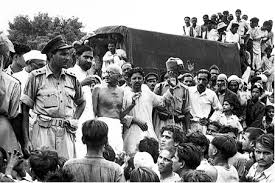
Mahatma Gandhi returned to India from South Africa in 1915 and quickly became the leader of the Indian freedom struggle. His philosophy of Satyagraha (truth-force) and Ahimsa (nonviolence) became the foundation of India’s fight against British colonial rule. Through mass movements, he united people from different regions, religions, and social backgrounds in the pursuit of Swaraj (self-rule).
Early Struggles (1915–1919)
1. Champaran and Kheda Satyagraha (1917–1918)
Gandhi’s first major movements in India were focused on helping farmers and peasants suffering under British exploitation:
- Champaran Satyagraha (Bihar, 1917): Farmers were forced to grow indigo instead of food crops and sell it at low prices to British planters. Gandhi led peaceful protests, forcing the British to abolish oppressive plantation policies.
- Kheda Satyagraha (Gujarat, 1918): A tax boycott movement where peasants refused to pay taxes due to famine and crop failures. The British were forced to provide relief.
These successful nonviolent protests marked the beginning of Gandhi’s leadership in India’s independence movement.
Mass Movements for Freedom
2. Non-Cooperation Movement (1920–1922)
- First nationwide movement against British rule.
- Encouraged Indians to boycott British schools, courts, clothes, and goods.
- People resigned from government jobs and gave up British titles.
- Led to massive protests, but was called off after the Chauri Chaura incident (1922), where protesters set a police station on fire.
Though the movement ended, it awakened national consciousness and united Indians in resistance.
3. Civil Disobedience Movement & Dandi Salt March (1930–1934)
- In 1930, Gandhi led the famous Dandi Salt March, walking 240 miles to the Arabian Sea in protest against British salt laws.
- Thousands joined the movement, breaking the salt laws by making salt from seawater.
- The movement spread across India, with protests, strikes, and boycotts.
- Resulted in Gandhi-Irwin Pact (1931), leading to temporary concessions but no full independence.
This movement intensified the demand for Swaraj and made Gandhi an international symbol of resistance.
4. Quit India Movement (1942) – “Do or Die”
- Launched on August 8, 1942, demanding immediate British withdrawal from India.
- Gandhi gave the call for “Do or Die”, urging Indians to fight for total independence.
- The British arrested Gandhi and thousands of leaders, leading to violent protests across the country.
- Despite repression, the movement weakened British control, making it clear that they could no longer rule India.
Road to Independence (1945–1947)
After World War II, the British were economically weak and faced increasing pressure to leave India.
- 1946: Direct negotiations for independence began.
- August 15, 1947: India finally achieved independence, but was divided into India and Pakistan.
- Gandhi, deeply hurt by partition violence, worked to restore peace, even fasting to stop communal riots.
On January 30, 1948, Mahatma Gandhi was assassinated by Nathuram Godse, a Hindu extremist, who blamed him for favoring Muslims and Pakistan.
Legacy
Gandhi’s nonviolent resistance influenced global leaders like Nelson Mandela and Martin Luther King Jr. His methods of peaceful protest remain a powerful tool for human rights and justice worldwide.